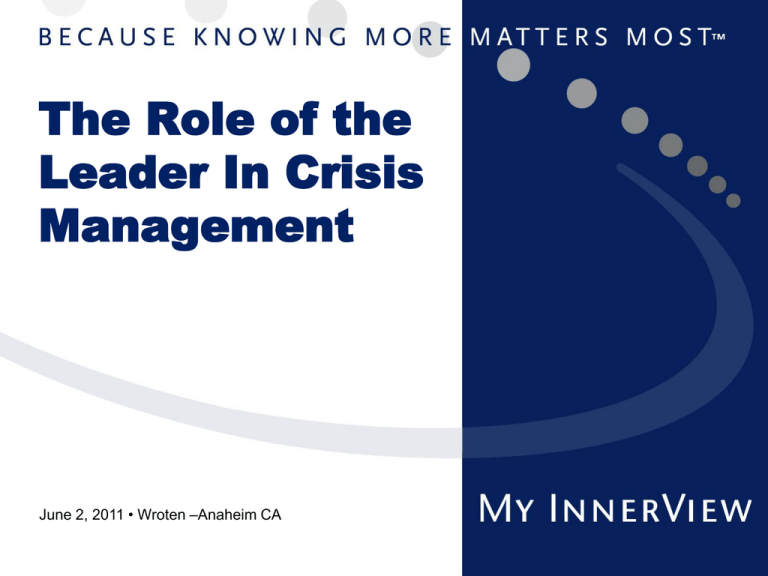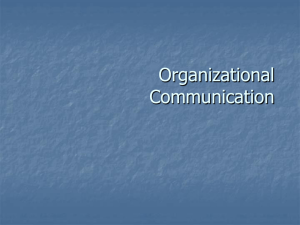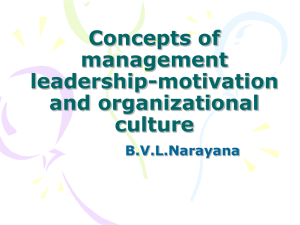The Role of the Leader In Crisis Management
advertisement

The Role of the Leader In Crisis Management June 2, 2011 • Wroten –Anaheim CA Mary Tellis-Nayak RN, MSN, MPH Vice President of Quality Initiatives mary@myinnerview.com 773-942-7525 Objectives The participant will be able to: 1. Identify 3 characteristics of the leaders we need for crisis management in longterm care 2. Articulate the characteristics of their own leadership style 3. Enumerate three ideas you heard about leading and managing at different times in a nursing home’s life. The Importance of Leadership Administrator and DON: The architects of excellence An organization excels or fails with its managers “80% of all quality problems are the fault of managers” W. EDWARDS DEMING MANAGER VS LEADER The manager maintains The leader develops The manager has a short-range view The leader has along-range perspective The manager focuses on systems and structure The leader focuses on people The manager asks how and when The manager accepts the status quo The manager does things right The leader asks what and why The leader challenges it (the status quo) The leader does the right thing Administrators and DONs are the KEY to quality Quality of care: QI Index Survey results The NHA/DON turnover is by far the best predictor of a quality collapse Family satisfaction Staff satisfaction Staff turnover Administrator turnover Every quality-related outcome turns direction and heads south Census Liability Finances Other When NHAs/DONs exit: The outcomes Quality of care: QI Index DON turnover in 2 years Survey results Family satisfaction 0 1 2+ Staff satisfaction Staff turnover Administrator turnover Census Liability NHA turnover in 2 years Finances Other 0 1 2+ Families “Very satisfied” Staff “Very satisfied” 0 1 2+ DON turnover in 2 years 0 1 2+ NHA turnover in 2 years Deficiency-free surveys Scope and severity of G and G+ 0 1 2+ DON turnover in 2 years 0 1 2+ NHA turnover in 2 years CNA turnover Registry use 0 1 2+ DON turnover in 2 years 0 1 2+ NHA turnover in 2 years Please read the Activity that has been provided. Then turn to your neighbor(s) and answer the questions on page 2. Did you know????? » A herd of buffalo is solely dependent on one leader – the herd will follow, even if it’s over a cliff. » In a flock of geese, every single bird within the group knows exactly where it is headed and is ready to take over the leadership at any given moment. WHAT MIGHT WE LEARN FROM GEESE? Let’s take each of the following facts and discuss how it would apply to the leadership in your organization. The Nature of Geese The goose in the front of the formation leads for a while, but as it tires it will drop back and another goose will take its place in front. Leadership and responsibility are shared by all. LESSON? As each goose flaps its wings, it creates an “uplift” for the birds that follow. By flying in a “V” formation, the whole flock adds 71% greater flying range than if each bird flew alone. LESSON? When a goose falls out of formation, it suddenly feels the drag and resistance of flying alone. It quickly moves back into formation to take advantage of the lifting power of the bird immediately in front of it. LESSON? When the lead goose tires, it rotates back into the formation to take advantage of the lifting power of the bird immediately in front of it. LESSON? The geese flying in formation honk to encourage those up front to keep up their speed. LESSON? When a goose gets sick, wounded or shot down, two geese drop out of formation and follow it down to help and protect it. They stay until it dies or is able to fly again. Then, they launch out with another formation or catch up with the flock. LESSON? The lesson from the geese! » Who are the “formal” leaders in our organization? » The geese teach us: – Everyone in an organization has the ability to be a leader. Great leaders create other leaders, not followers Leadership is essential in transforming our homes to a culture of quality, not a culture of compliance Let’s look into why … What is leadership? What is leadership? » Leadership is a complex process by which a person: – Influences others to accomplish a mission, task or objective and – Directs the organization in a way that makes it more cohesive and coherent Authority and leadership » Although your position as a manager, supervisor, etc. gives you the authority to accomplish certain tasks and objectives in the organization, this power does not make you a leader... it simply makes you the boss A leader makes people want to achieve high goals and objectives A boss tells people to accomplish a task or objective Qualities of Effective Leaders Think of someone in your life who has been an effective leader What qualities did he/she have? How people become leaders » Trait Theory » Great Events Theory » Transformational Leadership Theory Trait Theory » Some personality traits may lead people naturally into leadership roles » We have all met a few people like this, such as high school coach, scout leader, teacher or a good boss » There are very few people who have natural talent for leading others Great Events Theory » A crisis or important event may cause a person to rise to the occasion » This can bring out extraordinary leadership qualities in an ordinary person Transformational Leadership Theory » People can choose to become leaders » People can learn leadership skills This is most widely accepted theory today Good leaders are made, not born » Must have the desire and willpower » Good leaders develop through never-ending process of: – Self-study – Education – Training – Experience » Best leaders are continually working and studying to improve their leadership skills Qualities of an effective leader » Self-knowledge – self-understanding and self-confidence » Problem solving and ability to make decisions — decisiveness » Being able to respond quickly and effect change is crucial for a response system, especially in a crisis Qualities of an effective leader » Trust is the very core of leadership and cannot be established at the time of crisis — it must already exist » Clear communication is essential in any situation Questions to TO seeSEE if you QUESTIONS IF YOU ENGENDER Engender TRUSTWORTHINESS Trustworthiness » Ask yourself these questions to assess your trustworthiness: – Is my behavior predictable or erratic? • Do your values direct your actions and these don’t shift? – Do I communicate clearly or carelessly? • Do you say things you haven’t clearly thought out? – Do I treat my promises seriously or lightly? • Do I keep my promises? – Am I forthright or dishonest? • Do I ever mislead others or lie? Actions speak louder than attributes » What you DO speaks to what you ARE – Everything you do effects the organization’s objectives and their well being » Employees will OBEY but not FOLLOW a self-serving leader » Leaders often succeed because they present a good image to their seniors at the expense of their team EXERCISE Let’s discuss examples of rules that are contradictory: 1. We communicate we respect employees and their time but we regularly start our meetings 15 minutes late 2. We say employees are our most valuable asset but we hire the first “warm body” that applies 3. We tell employees we value excellence yet we ask more and more from our top performers while tolerating mediocrity and poor performance from others How do organizations encourage leadership development? » Providing training, support and constructive feedback as employees carry out their responsibilities (coaching) » Delegating responsibilities to team members and expecting them to handle the details …“Do what you do best and give away the rest to someone else” Coaching » Every interaction with team members is a coaching occasion » “To coach” comes from the root meaning “to bring a person from where they are to where they want to be” » Coaching begins with creating an environment where people want to be part of a winning team Effective delegation involves: » Identifying an appropriate person for the task » Preparing the person by clearly stating desired outcomes while encouraging risk-taking and innovation » Ensuring that the person has the necessary authority to do the job properly » Holding the person accountable for agreed-upon outcomes » Maintaining enough contact for support and monitoring of progress without “hovering” » Acknowledging success and giving creidt when due. Determining Your Leadership Style When your boss puts you in charge of organizing the company holiday party, what do you do first? » Do you develop a timeline and start assigning tasks? » Do you think about who would prefer to do what and try to schedule around their needs? » When the planning starts to fall behind schedule, what is your first reaction? – Do you chase everyone to get back on track? – Do you ease off a bit recognizing that everyone is busy just doing his/her job, let alone the extra tasks you’ve assigned? Your answers to these questions can reveal a great deal about your personal leadership style Neither preference is right or wrong, just as no one type of leadership style is best for all situations. However, it’s useful to understand what your natural leadership tendencies are, so that you can then working on developing skills that you may be missing. Blake Mouton Managerial Grid BALANCING TASKAND PEOPLE-ORIENTED LEADERSHIP While the grid does not entirely address the complexity of “Which leadership style is best?”, it certainly provides an excellent starting place to critically analyze your own performance and improve your general leadership skills MANAGERIAL GRID: BASED ON TWO BEHAVIORAL DIMENSIONS Concern for people – This is the degree to which a leader considers the needs of team members, their interests, and areas of personal development when deciding how best to accomplish a task Concern for production – This is the degree to which a leader emphasizes concrete objectives, organizational efficiency and high productivity when deciding how best to accomplish a task High Concern for people Low High Concern for production COUNTRY CLUB LEADERSHIP: HIGH PEOPLE/ LOW PRODUCTION » This style of leader is most concerned about the needs and feelings of members of his/her team » These people operate under the assumption that as long as team members are happy and secure then they will work hard » What tends to result is a work environment that is very relaxed and fun but where production suffers due to lack of direction and control PRODUCE OR PERISH LEADERSHIP: HIGH PRODUCTION/LOW PEOPLE » Also known as Authoritarian or Compliance Leaders, people in this category believe that employees are simply means to an end » Employee needs are always secondary to need for efficient and productive workplaces » This type of leader is very autocratic, has strict work rules, policies and procedures, and views punishment as the most effective means to motivate employees IMPOVERISHED LEADERSHIP: LOW PRODUCTION/ LOW PEOPLE » This leader is mostly ineffective » He/she has neither a high regard for: – Creating systems – Getting the job done – Nor for creating work environment that is satisfying and motivating » The result is a place of disorganization, dissatisfaction and disharmony MIDDLE-OF-THE-ROAD LEADERSHIP: MEDIUM PRODUCTION/MEDIUM PEOPLE » This style seems to be balance of the two competing concerns » May at first appear to be an ideal compromise » Therein lies the problem, though: – When you compromise, you necessarily give away a bit of each concern so that neither production nor people needs are fully met » Leaders who use this style settle for average performance and often believe that this is the most anyone can expect TEAM LEADERSHIP: HIGH PRODUCTION/ HIGH PEOPLE » This is pinnacle of managerial style » These leaders stress production needs and needs of people equally highly » Premise here is that employees are involved in understanding organizational purpose and determining production needs – When employees are committed to and have stake in organization’s success, their needs and production needs coincide – This creates team environment based on trust and respect, which leads to high satisfaction and motivation and, as a result, high production Identify areas of improvement and develop your leadership skills Look at your current leadership method and critically analyze its effectiveness Look at ways you can improve — Are you settling for ‘middle of the road’ because it is easier than reaching for more? LTC LEADERS: IS THERE A LEADER FOR ALL SEASONS? • In reality, an LTC leader operates in a specific setting • An LTC leader is a unique combination of one’s biography, personality, an internal calling and a social setting • Each LTC leader brings to the role different personal resources A SPECIAL LEADER FOR SPECIAL SEASONS • Different social environments demand different types of leaders, different styles and different skills • In different settings you expect leaders to achieve different outcomes • You measure an LTC leader’s success by: • how well the leader reads the challenge she/he faces • how well she/he matches their approach to the problem • what outcomes her/his approach produces Grounded Leadership Model Role of LTC Leader Environment: Context, situation, challenge Leadership skills and style matched Measures of leadership success Leaders by Settings 3 Nursing Homes Environment & challenge Matched skills in leadership Measures of success » No systems » Demand discipline » No G citations, less agency use, less turnover & absenteeism » Achieve compliance Substandard NH » Achieve compliance Leaders by Settings Mediocre NH Environment & challenge Matched skills in leadership Measures of success » Haphazard systems »Unstable systems » Seek excellence » Motivate, educate » Improve QIs, satisfaction, survey results Leaders by Settings Environment & challenge Matched skills in leadership Measures of success » Model systems » Inspire new heights of excellence » Innovation » Seek new frontiers » Fine-tune systems Exemplary NH » Serve as model » Win awards Leaders by Settings 3 Nursing Homes Exemplary NH Mediocre NH Substandard NH Environment & challenge Matched skills in leadership Measures of success » Model systems » Fine-tune systems » Innovation » Inspire greater excellence » Win awards » Haphazard systems »Unstable systems » Seek excellence » Motivate, educate » Improve QIs, satisfaction, survey results » No systems » Demand discipline » Seek new frontiers » Achieve compliance » Achieve compliance » Serve as model » No G citations, less agency use, less turnover & absenteeism Leadership Best Practices Employees speak out about leadership Listen to your employees The truths of leadership you need to know: 1. We are watching everything you do If you show up late for a meeting, you are telling us you don’t value OUR time If you lose your cool over small issues, we wonder how you will react with big ones You are ALWAYS leading, you can’t NOT lead 2. Everything you do counts Sharing juicy gossip and remove yourself from your leadership role? NO TIME OUTS What you say to us outside the office COUNTS Listen to your employees 3. We have expectations of you Hire great people – this is one of the most important things you do Don’t just hire any “warm body” just to fill a position You can be the best manager in the world but if we have people on the team who are not talented, we will not be successful “De-hire” those on the team who are NOT contributing to the mission They are more detrimental than any of our competitors If we get lucky, our competitor will hire them Treat us with respect You need us just as much as we need you … sometimes even more Voice of Employees AN EXERCISE: What Matters Most QUADRANT ANALYSIS: TWO KEY CONCEPTS 1. How staff rate your care and services Your average score on each item: 1 – 4: “Poor” “Fair” “Good” “Excellent” Rank order all items by average score: 1 – 100: Lowest to highest ranking score 2. How much each item influences staff to recommend to others Correlate each item with “Recommendation: 0 – 1: No correlation to strongest correlation Rank order all items by correlational strength: 1 – 100: Lowest to highest ranking correlation Item score B. Secondary strengths Primary strengths C. D. Secondary opportunities Primary opportunities 1 ----- Lowest to highest ranking correlation ------ 100 You have little control over employee expectations Successes A. Recommendation Challenges 1 - Lowest to highest ranking score - 100 You can meet employee expectations QUADRANT AND ACTION PRIORITIES SKILLED NURSING EMPLOYEE Survey items 1 Quality of orientation 11 Safety of workplace 2 Quality of in-service education 3 Quality of resident-related training 12 Adequacy of equipment/supplies 4 Quality of family-related training 5 Comparison of pay 6 Care (concern) of supervisor 7 Appreciation of supervisor 8 Communication by supervisor 9 Attentiveness of management 10 Care (concern) of management 13 Sense of accomplishment 14 Quality of teamwork 15 Fairness of evaluations 16 Respectfulness of staff 17 Assistance with job stress 18 Staff-to-staff communication EMPLOYEES NATIONWIDE What matters most 10 - Care (concern) of management 9 - Attentiveness of management 17 - Assistance with job stress 11 - Safety of workplace 12 - Adequacy of equipment/supplies 6 - Care (concern) of supervisor 7 - Appreciation of supervisor 8 - Communication by supervisor 3 - Quality of resident-related training 15 - Fairness of evaluations DATABYTE EMPLOYEE EMPLOYEE Safety of workplace Care (concern) of supervisor Communication by supervisor Appreciation of supervisor Equipment/supplies Resident-related training Care (concern) of management Attentiveness of management Assistance with job stress What does research have to tell us about the workplace? Quality of leadership and quality of the workplace The voice of CNAs » Based on 2008 satisfaction surveys conducted by My InnerView: – 78,547 CNAs/NAs – 144,098 family members » 3,216 skilled nursing facilities ranked in four groups based on percentiles (lowest, 2nd lowest, 2nd highest and highest) Indicators of quality workplace 1. Pay compared to other nursing homes 2. Safety of workplace 3. Adequate equipment and supplies to do your job 4. Work allows you to make a difference in people's lives 5. Co-workers work together as a team 6. Fair performance evaluations 7. Respect shown for resident by staff 8. Help you get to deal with job stress and burnout 9. Staff communication between shifts Quality leaders produce a quality workplace Group averge score: 1-4 80 Workplace Leadership Workplace Leadership Workplace Leadership Workplace 40 Leadership 60 20 Lowest 2nd lowest 2nd hi ghest Highest Based on My InnerView employee satisfaction surveys completed by CNAs/NAs in 2008. Quality workplace earns staff recommendation Group averge score: 1-4 80 Recommendatio n Workplace Recommendatio n Workplace Recommendatio n Workplace Recommendatio n 40 Workplace 60 20 Lowest 2nd lowest 2nd hi ghest Highest Based on My InnerView employee satisfaction surveys completed by CNAs/NAs in 2008. Quality workplace earns family recommendation Group averge score: 1-4 80 Recommendatio n Workplace Recommendatio n Workplace Recommendatio n Workplace Recommendatio n 40 Workplace 60 20 Lowest 2nd lowest 2nd highest Highest Based on My InnerView employee satisfaction surveys completed by CNAs/NAs in 2008. Quality workplace creates quality of life for resident Group averge score: 1-4 80 Quality of life Workplace Quality of life Workplace Quality of life Workplace Quality of life 40 Workplace 60 20 Lowest 2nd lowest 2nd hi ghest Highest Based on My InnerView employee satisfaction surveys completed by CNAs/NAs in 2008. As staff are treated, so will the elders be treated. Quality workplace creates quality of care for resident Group averge score: 1-4 80 Quality of care Workplace Quality of care Workplace Quality of care Workplace Quality of care 40 Workplace 60 20 Lowest 2nd lowest 2nd hi ghest Highest Based on My InnerView employee satisfaction surveys completed by CNAs/NAs in 2008. Quality workplace creates quality of service for resident Group averge score: 1-4 80 Quality of service Workplace Quality of service Workplace Quality of service Workplace Quality of service 40 Workplace 60 20 Lowest 2nd lowest 2nd hi ghest Highest Based on My InnerView employee satisfaction surveys completed by CNAs/NAs in 2008. Quality workplace results in better state surveys 120 80 0 Lowest 2nd lowest 2nd hi ghest Highest Based on My InnerView employee satisfaction surveys completed by CNAs/NAs in 2008. Survey citations Compliance Workplace Survey citations Compliance Workplace Survey citations Compliance Workplace 20 Survey citations 40 Compliance 60 Workplace Group averge score: 1-4 100 How do you show you care about your employees? Let’s Talk About Communication A paradox » Employees are frustrated by perceived lack of communication with their managers » Most managers feel they are outstanding communicators A recent study discovered that 90%of the managers rated their communication skills in the top 10% of all managers “Sixty percent of all management problems are the result of poor or faulty communication.” PETER DRUCKER What was wrong with this communication? Another paradox » Communication may not be the problem » Communicating more may not be the solution » Most of the information employees receive: – Doesn’t get read – That which is read is often not understood – That which is understood is usually not remembered » Communication being delivered is not the same as the message being received Let’s talk about communication » What are some of the barriers to communication? – It is difficult to “hear’ messages during a crisis – Staff, residents, families – each have their “own” sources of stress during a crisis • understanding each person in crisis and how they may react is important HOW DO YOU LIKE BEST TO RECEIVE COMMUNICATION? WHAT IS THE WAY YOU MOST FREQUENTLY COMMUNICATE WITH YOUR EMPLOYEES? Communication as an outcome – not an activity » We pay more attention to the HOW we’re going to communicate than to the WHAT » Proliferation of communication methods E-mail Voice mail Meetings Conference calls Cell phones Pagers Memos Video Intranets Newsletters Text message Understanding communication » Understanding does not mean agreement » Goals – To build support and acceptance – To have receivers internalize the message – To move them to action » Understanding is intellectual » Support and acceptance are emotional And that’s what happened to dinosours How Audiences Judge Messages » Timeliness – The first message received on a subject sets the stage. – Response time can also indicate to the “hearer” your level of preparedness » Content and Credibility – First impressions are lasting – A great message delivered after the audience has moved on is a message not delivered at all. – Consistent messages are vital – speak with one voice » Empathy and Caring – Expressed within the first 30 seconds – Provides a greater opportunity for your message to be received and acted upon – Important to have established a relationship BEFORE the disaster. Make Sure Your Message is Clear » Present information in sequence » Avoid jargon, codes, and acronyms » Use common names » Omit unnecessary detail » Speak in sync » Keep messages consistent » Make every word count How do you show you care about your employees? The biggest investment is TIME 1. Schedule time to focus on employee development 2. Ask about interests outside of work 3. Treat everyone with respect and dignity 4. Say “thank you” 5. Get employees involved and ask for their opinion 6. Remember birthdays and service anniversaries 7. Support employees in times of crisis 8. Be available when people need you 9. Help co-workers become more effective 10.Surround good people with other good people Walking the Talk Survey results » Only 14% of employees said they had a positive role model at work » 86% couldn’t identify even one person at work they wanted to emulate! Survey results » “I let my team members know when they are doing a good job” – Mangers rated themselves 4.3 when 5 = always » “My supervisor lets me know what I am doing a good job” – Team members rated their managers a 2.3 » Why the disparity? Performance groupings » Super Stars – 10% of staff or if REALLY lucky, up to 30% » Middle Stars – About 50% of the team are inconsistent performers – They may be new or just not have the motivation to be super stars » Falling Stars – The rest – They consistently fail to carry their share of the load – They probably are preventing the top performers from doing their jobs as well EXERCISE » Write down the names of people on your team whom you would place in the: – Super Star category – Middle Star category – Falling Star category » Are their significant differences in the behavioral traits of the 3 groups? When you get back to work… » Pull out their performance reviews – do they reflect your current thinking? » Is there a noticeable difference among the 3 categories? » If there are few differences, it will be difficult for you to effectively coach your Super, Middle and Falling Stars Raising the bottom, not lowering the top » Don’t abuse them by giving them more work » Coaching the Super Stars: – – – – – – – – – – Get them involved Delegate extensively Encourage them to teach Provide training Have them to fill in for you Stretch them Celebrate their successes Tell them how proud you are to have them on the team Spend time with them Promote them Coaching the Middle Stars » Build their confidence by increasing their responsibilities » Give frequent and accurate performance feedback » Create a resource library » Teach them how to set goals » Catch them doing good things » Hook them up with a super star » Create rewards that appeal to THEIR personal values Coaching Falling Stars » Help them improve » Replace them with more productive people This represents the area with the greatest opportunity for enhancing the overall performance of your work group They can have a very detrimental impact on your team — the top performers will pick up more work What will “I” do differently? Exercise » What are three things you would do when you return to your facility to strengthen your leadership? » What 2 leadership skills/traits/characteristics would you call upon to ensure success? » What 2 things will you do to “coach” your department heads/managers to ensure they embody your vision? » What characteristics do YOU need to build to be a better leader in times of crisis? The importance of follow-up: Leadership Calendar » Mark 12 different days on your calendar spread out over 8 months » After the end of that day, write down some leadership behavior that you exercised during the previous period (or that day) » Ask yourself: – How did I feel about my action or behavior? – How does this action or behavior jive with what I know about leadership best practices? We did the best we could, with what we knew, And when we knew better, we did better Maya Angelou A Minneapolis couple decided to go to Florida to thaw out during a particularly icy winter. They planned to stay at the same hotel where they spent their honeymoon 20 years earlier. Because of hectic schedules, it was difficult to coordinate their travel schedules. So, the husband left Minnesota and flew to Florida on Thursday, with his wife flying down the following day. The husband checked into the hotel. There was a computer in his room. He decided to send an email to his wife. However, he accidentally left out one letter in her e-mail address, and without realizing his error, he sent the e-mail. Meanwhile, somewhere in Houston, a widow had just returned home from her husband's funeral. He was a pastor who was called home to glory following a heart attack. The widow decided to check her e-mail expecting messages from family and friends. After reading the first message, she screamed and fainted. The widow's son rushed into the room, found his mother on the floor passed out. He looked at the computer, which read: To: My Loving Wife Subject: I've Arrived Date: March 2, 2009 I know you're surprised to hear from me. They have computers here now and you are allowed to send emails to your loved ones. I've just arrived and have been checked in. I've seen that everything has been prepared for your arrival tomorrow. Looking forward to seeing you then!!!! Hope your journey is as uneventful as mine was. P.S. Sure is freaking hot down here!!!! Mary Tellis-Nayak RN, MSN, MPH Vice President of Quality Initiatives mary@myinnerview.com 773-942-7525







